算法分析与设计 第二版 英文版 (潘彦 著) 清华大学出版社 课后答案--solu4
- 格式:pdf
- 大小:313.84 KB
- 文档页数:44
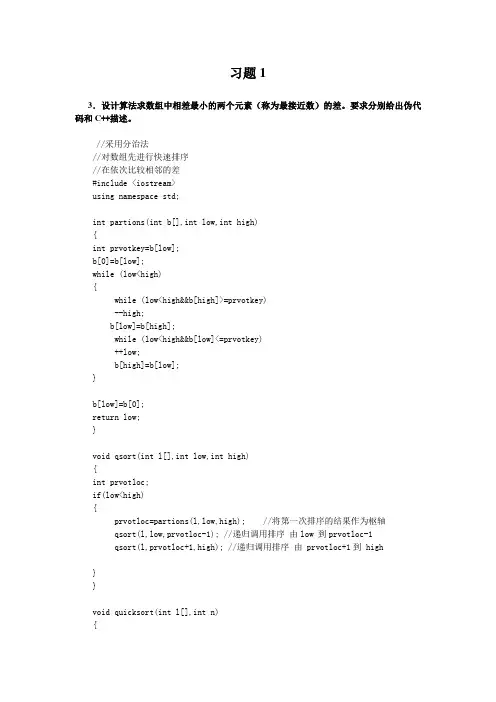
习题13.设计算法求数组中相差最小的两个元素(称为最接近数)的差。
要求分别给出伪代码和C++描述。
//采用分治法//对数组先进行快速排序//在依次比较相邻的差#include <iostream>using namespace std;int partions(int b[],int low,int high){int prvotkey=b[low];b[0]=b[low];while (low<high){while (low<high&&b[high]>=prvotkey)--high;b[low]=b[high];while (low<high&&b[low]<=prvotkey)++low;b[high]=b[low];}b[low]=b[0];return low;}void qsort(int l[],int low,int high){int prvotloc;if(low<high){prvotloc=partions(l,low,high); //将第一次排序的结果作为枢轴qsort(l,low,prvotloc-1); //递归调用排序由low 到prvotloc-1qsort(l,prvotloc+1,high); //递归调用排序由 prvotloc+1到 high}}void quicksort(int l[],int n){qsort(l,1,n); //第一个作为枢轴,从第一个排到第n个}int main(){int a[11]={0,2,32,43,23,45,36,57,14,27,39};int value=0;//将最小差的值赋值给valuefor (int b=1;b<11;b++)cout<<a[b]<<' ';cout<<endl;quicksort(a,11);for(int i=0;i!=9;++i){if( (a[i+1]-a[i])<=(a[i+2]-a[i+1]) )value=a[i+1]-a[i];elsevalue=a[i+2]-a[i+1];}cout<<value<<endl;return 0;}4.设数组a[n]中的元素均不相等,设计算法找出a[n]中一个既不是最大也不是最小的元素,并说明最坏情况下的比较次数。

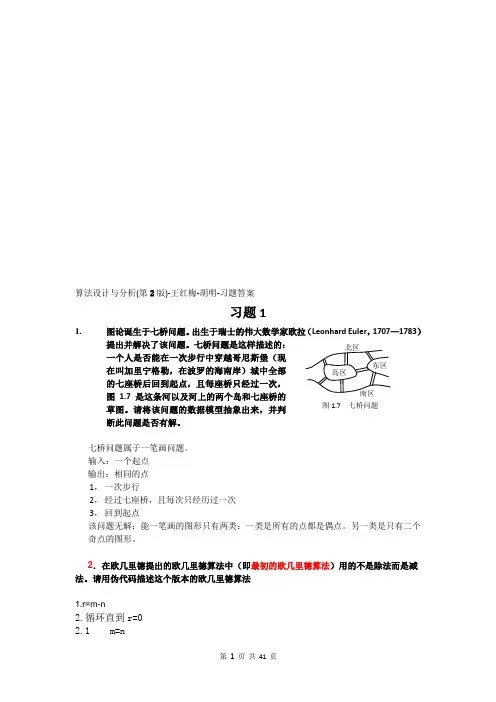
算法设计与分析(第2版)-王红梅-胡明-习题答案习题11. 图论诞生于七桥问题。
出生于瑞士的伟大数学家欧拉(Leonhard Euler ,1707—1783)提出并解决了该问题。
七桥问题是这样描述的:一个人是否能在一次步行中穿越哥尼斯堡(现在叫加里宁格勒,在波罗的海南岸)城中全部的七座桥后回到起点,且每座桥只经过一次,图 1.7是这条河以及河上的两个岛和七座桥的草图。
请将该问题的数据模型抽象出来,并判断此问题是否有解。
七桥问题属于一笔画问题。
输入:一个起点输出:相同的点1, 一次步行2, 经过七座桥,且每次只经历过一次3, 回到起点该问题无解:能一笔画的图形只有两类:一类是所有的点都是偶点。
另一类是只有二个奇点的图形。
2.在欧几里德提出的欧几里德算法中(即最初的欧几里德算法)用的不是除法而是减法。
请用伪代码描述这个版本的欧几里德算法1.r=m-n2.循环直到r=02.1 m=n图1.7 七桥问题2.2 n=r2.3 r=m-n3 输出m3.设计算法求数组中相差最小的两个元素(称为最接近数)的差。
要求分别给出伪代码和C++描述。
//采用分治法//对数组先进行快速排序//在依次比较相邻的差#include <iostream>using namespace std;int partions(int b[],int low,int high){int prvotkey=b[low];b[0]=b[low];while (low<high){while (low<high&&b[high]>=prvotkey)--high;b[low]=b[high];while (low<high&&b[low]<=prvotkey)++low;b[high]=b[low];}b[low]=b[0];return low;}void qsort(int l[],int low,int high){int prvotloc;if(low<high){prvotloc=partions(l,low,high); //将第一次排序的结果作为枢轴qsort(l,low,prvotloc-1); //递归调用排序由low 到prvotloc-1qsort(l,prvotloc+1,high); //递归调用排序由 prvotloc+1到 high}}void quicksort(int l[],int n){qsort(l,1,n); //第一个作为枢轴,从第一个排到第n个}int main(){int a[11]={0,2,32,43,23,45,36,57,14,27,39};int value=0;//将最小差的值赋值给valuefor (int b=1;b<11;b++)cout<<a[b]<<' ';cout<<endl;quicksort(a,11);for(int i=0;i!=9;++i){if( (a[i+1]-a[i])<=(a[i+2]-a[i+1]) )value=a[i+1]-a[i];elsevalue=a[i+2]-a[i+1];}cout<<value<<endl;return 0;}4.设数组a[n]中的元素均不相等,设计算法找出a[n]中一个既不是最大也不是最小的元素,并说明最坏情况下的比较次数。
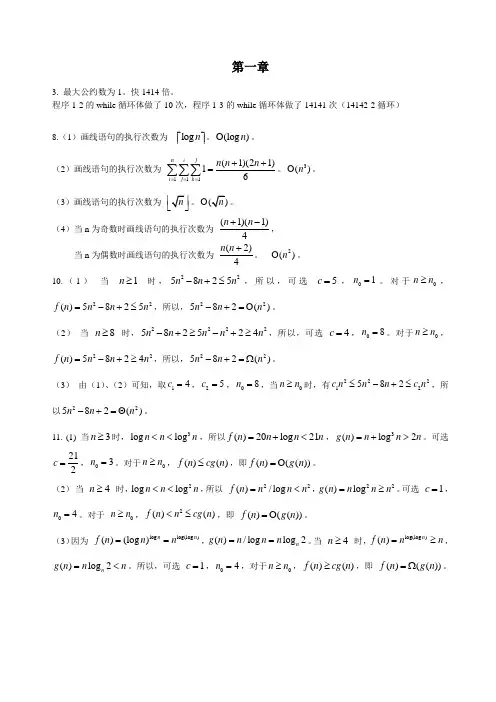
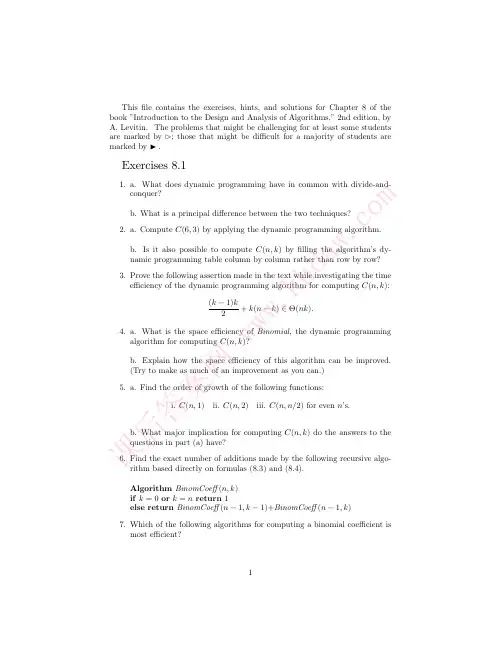
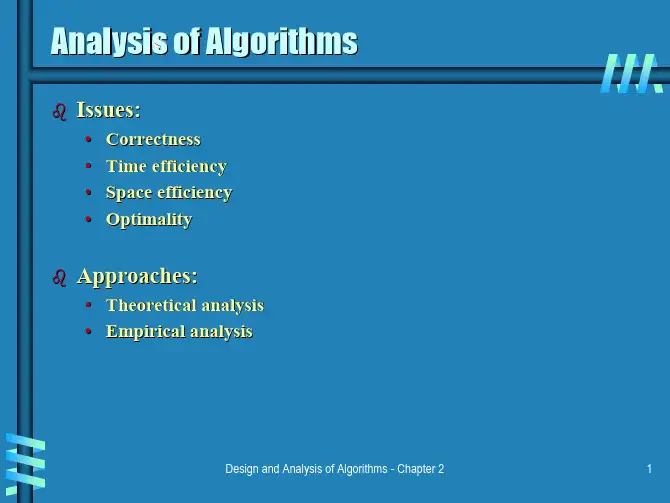
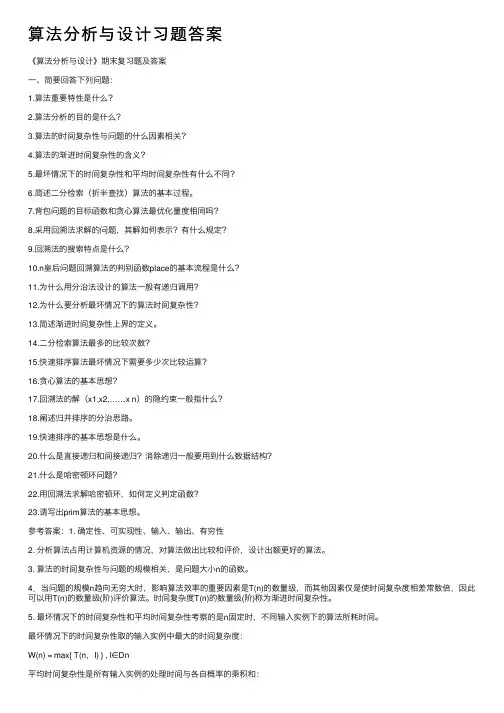
算法分析与设计习题答案《算法分析与设计》期末复习题及答案⼀、简要回答下列问题:1.算法重要特性是什么?2.算法分析的⽬的是什么?3.算法的时间复杂性与问题的什么因素相关?4.算法的渐进时间复杂性的含义?5.最坏情况下的时间复杂性和平均时间复杂性有什么不同?6.简述⼆分检索(折半查找)算法的基本过程。
7.背包问题的⽬标函数和贪⼼算法最优化量度相同吗?8.采⽤回溯法求解的问题,其解如何表⽰?有什么规定?9.回溯法的搜索特点是什么?10.n皇后问题回溯算法的判别函数place的基本流程是什么?11.为什么⽤分治法设计的算法⼀般有递归调⽤?12.为什么要分析最坏情况下的算法时间复杂性?13.简述渐进时间复杂性上界的定义。
14.⼆分检索算法最多的⽐较次数?15.快速排序算法最坏情况下需要多少次⽐较运算?16.贪⼼算法的基本思想?17.回溯法的解(x1,x2,……x n)的隐约束⼀般指什么?18.阐述归并排序的分治思路。
19.快速排序的基本思想是什么。
20.什么是直接递归和间接递归?消除递归⼀般要⽤到什么数据结构?21.什么是哈密顿环问题?22.⽤回溯法求解哈密顿环,如何定义判定函数?23.请写出prim算法的基本思想。
参考答案:1. 确定性、可实现性、输⼊、输出、有穷性2. 分析算法占⽤计算机资源的情况,对算法做出⽐较和评价,设计出额更好的算法。
3. 算法的时间复杂性与问题的规模相关,是问题⼤⼩n的函数。
4.当问题的规模n趋向⽆穷⼤时,影响算法效率的重要因素是T(n)的数量级,⽽其他因素仅是使时间复杂度相差常数倍,因此可以⽤T(n)的数量级(阶)评价算法。
时间复杂度T(n)的数量级(阶)称为渐进时间复杂性。
5. 最坏情况下的时间复杂性和平均时间复杂性考察的是n固定时,不同输⼊实例下的算法所耗时间。
最坏情况下的时间复杂性取的输⼊实例中最⼤的时间复杂度:W(n) = max{ T(n,I) } , I∈Dn平均时间复杂性是所有输⼊实例的处理时间与各⾃概率的乘积和:A(n) =∑P(I)T(n,I) I∈Dn6. 设输⼊是⼀个按⾮降次序排列的元素表A[i:j] 和x,选取A[(i+j)/2]与x⽐较,如果A[(i+j)/2]=x,则返回(i+j)/2,如果A[(i+j)/2]回溯法的搜索特点是什么7. 不相同。
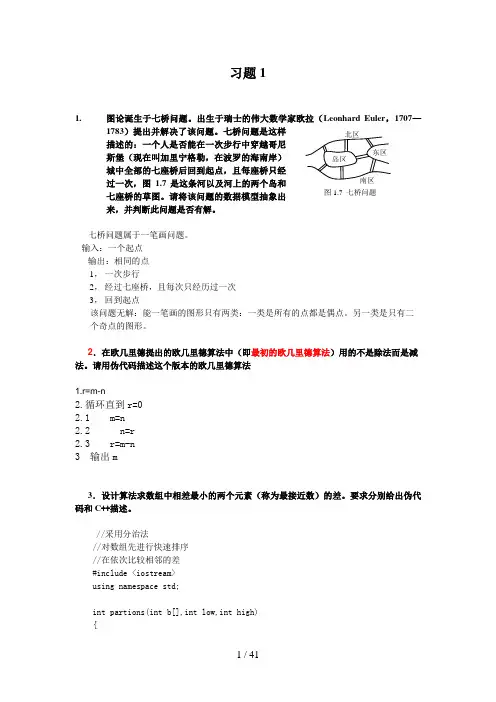
习题11. 图论诞生于七桥问题。
出生于瑞士的伟大数学家欧拉(Leonhard Euler ,1707—1783)提出并解决了该问题。
七桥问题是这样描述的:一个人是否能在一次步行中穿越哥尼斯堡(现在叫加里宁格勒,在波罗的海南岸)城中全部的七座桥后回到起点,且每座桥只经过一次,图 1.7是这条河以及河上的两个岛和七座桥的草图。
请将该问题的数据模型抽象出来,并判断此问题是否有解。
七桥问题属于一笔画问题。
输入:一个起点输出:相同的点1, 一次步行2, 经过七座桥,且每次只经历过一次3, 回到起点该问题无解:能一笔画的图形只有两类:一类是所有的点都是偶点。
另一类是只有二个奇点的图形。
2.在欧几里德提出的欧几里德算法中(即最初的欧几里德算法)用的不是除法而是减法。
请用伪代码描述这个版本的欧几里德算法1.r=m-n2.循环直到r=02.1 m=n2.2 n=r2.3 r=m-n3 输出m3.设计算法求数组中相差最小的两个元素(称为最接近数)的差。
要求分别给出伪代码和C ++描述。
//采用分治法//对数组先进行快速排序//在依次比较相邻的差#include <iostream>using namespace std;int partions(int b[],int low,int high) {图1.7 七桥问题int prvotkey=b[low];b[0]=b[low];while (low<high){while (low<high&&b[high]>=prvotkey)--high;b[low]=b[high];while (low<high&&b[low]<=prvotkey)++low;b[high]=b[low];}b[low]=b[0];return low;}void qsort(int l[],int low,int high){int prvotloc;if(low<high){prvotloc=partions(l,low,high); //将第一次排序的结果作为枢轴 qsort(l,low,prvotloc-1); //递归调用排序由low 到prvotloc-1qsort(l,prvotloc+1,high); //递归调用排序由 prvotloc+1到 high}}void quicksort(int l[],int n){qsort(l,1,n); //第一个作为枢轴,从第一个排到第n个}int main(){int a[11]={0,2,32,43,23,45,36,57,14,27,39};int value=0;//将最小差的值赋值给valuefor (int b=1;b<11;b++)cout<<a[b]<<' ';cout<<endl;quicksort(a,11);for(int i=0;i!=9;++i){if( (a[i+1]-a[i])<=(a[i+2]-a[i+1]) )value=a[i+1]-a[i];elsevalue=a[i+2]-a[i+1];}cout<<value<<endl;return 0;}4.设数组a[n]中的元素均不相等,设计算法找出a[n]中一个既不是最大也不是最小的元素,并说明最坏情况下的比较次数。
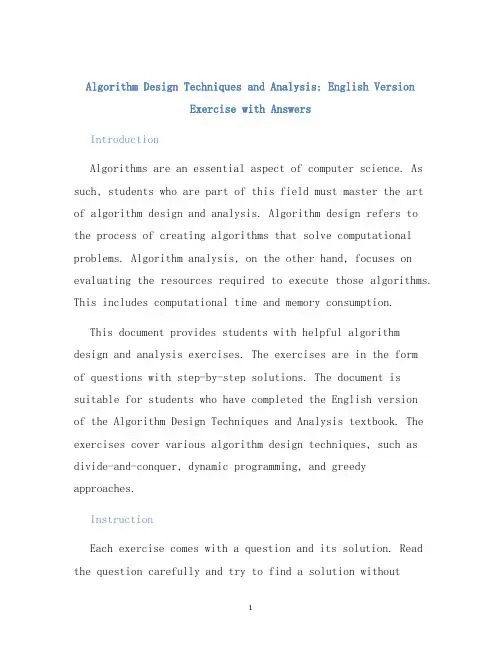
Algorithm Design Techniques and Analysis: English VersionExercise with AnswersIntroductionAlgorithms are an essential aspect of computer science. As such, students who are part of this field must master the art of algorithm design and analysis. Algorithm design refers to the process of creating algorithms that solve computational problems. Algorithm analysis, on the other hand, focuses on evaluating the resources required to execute those algorithms. This includes computational time and memory consumption.This document provides students with helpful algorithm design and analysis exercises. The exercises are in the formof questions with step-by-step solutions. The document is suitable for students who have completed the English versionof the Algorithm Design Techniques and Analysis textbook. The exercises cover various algorithm design techniques, such as divide-and-conquer, dynamic programming, and greedy approaches.InstructionEach exercise comes with a question and its solution. Read the question carefully and try to find a solution withoutlooking at the answer first. If you get stuck, look at the solution. Lastly, try the exercise agn without referring to the answer.Exercise 1: Divide and ConquerQuestion:Given an array of integers, find the maximum possible sum of a contiguous subarray.Example:Input: [-2, -3, 4, -1, -2, 1, 5, -3]Output: 7 (the contiguous subarray [4, -1, -2, 1, 5]) Solution:def max_subarray_sum(arr):if len(arr) ==1:return arr[0]mid =len(arr) //2left_arr = arr[:mid]right_arr = arr[mid:]max_left_sum = max_subarray_sum(left_arr)max_right_sum = max_subarray_sum(right_arr)max_left_border_sum =0left_border_sum =0for i in range(mid-1, -1, -1):left_border_sum += arr[i]max_left_border_sum =max(max_left_border_sum, left_b order_sum)max_right_border_sum =0right_border_sum =0for i in range(mid, len(arr)):right_border_sum += arr[i]max_right_border_sum =max(max_right_border_sum, righ t_border_sum)return max(max_left_sum, max_right_sum, max_left_border_s um+max_right_border_sum)Exercise 2: Dynamic ProgrammingQuestion:Given a list of lengths of steel rods and a corresponding list of prices, determine the maximum revenue you can get by cutting these rods into smaller pieces and selling them. Assume the cost of each cut is 0.Lengths: [1, 2, 3, 4, 5, 6, 7, 8]Prices: [1, 5, 8, 9, 10, 17, 17, 20]If the rod length is 4, the maximum revenue is 10.Solution:def max_revenue(lengths, prices, n):if n ==0:return0max_val =float('-inf')for i in range(n):max_val =max(max_val, prices[i] + max_revenue(length s, prices, n-i-1))return max_valExercise 3: Greedy AlgorithmQuestion:Given a set of jobs with start times and end times, find the maximum number of non-overlapping jobs that can be scheduled.Start times: [1, 3, 0, 5, 8, 5]End times: [2, 4, 6, 7, 9, 9]Output: 4Solution:def maximum_jobs(start_times, end_times):job_list =sorted(zip(end_times, start_times))count =0end_time =float('-inf')for e, s in job_list:if s >= end_time:count +=1end_time = ereturn countConclusionThe exercises presented in this document provide a practical way to master essential algorithm design and analysis techniques. Solving the problems without looking at the answers will expose students to the type of problems they might encounter in real life. The document’s solutionsprovide step-by-step instructions to ensure that students can approach the problems with confidence.。
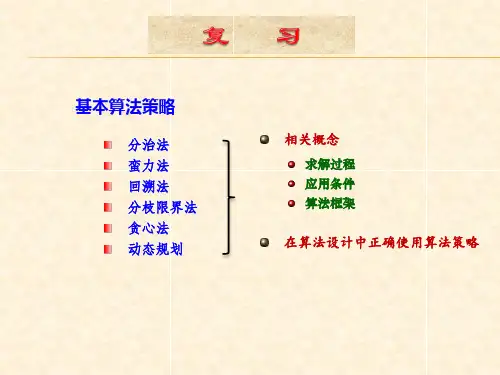
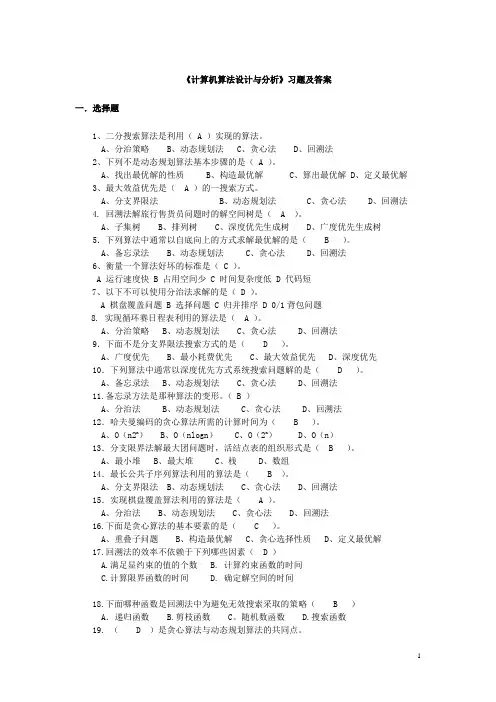
《计算机算法设计与分析》习题及答案一.选择题1、二分搜索算法是利用( A )实现的算法。
A、分治策略B、动态规划法C、贪心法D、回溯法2、下列不是动态规划算法基本步骤的是( A )。
A、找出最优解的性质B、构造最优解C、算出最优解D、定义最优解3、最大效益优先是( A )的一搜索方式。
A、分支界限法B、动态规划法C、贪心法D、回溯法4. 回溯法解旅行售货员问题时的解空间树是( A )。
A、子集树B、排列树C、深度优先生成树D、广度优先生成树5.下列算法中通常以自底向上的方式求解最优解的是( B )。
A、备忘录法B、动态规划法C、贪心法D、回溯法6、衡量一个算法好坏的标准是( C )。
A 运行速度快B 占用空间少C 时间复杂度低D 代码短7、以下不可以使用分治法求解的是( D )。
A 棋盘覆盖问题B 选择问题C 归并排序D 0/1背包问题8. 实现循环赛日程表利用的算法是( A )。
A、分治策略B、动态规划法C、贪心法D、回溯法9.下面不是分支界限法搜索方式的是( D )。
A、广度优先B、最小耗费优先C、最大效益优先D、深度优先10.下列算法中通常以深度优先方式系统搜索问题解的是( D )。
A、备忘录法B、动态规划法C、贪心法D、回溯法11.备忘录方法是那种算法的变形。
( B )A、分治法B、动态规划法C、贪心法D、回溯法12.哈夫曼编码的贪心算法所需的计算时间为( B )。
A、O(n2n)B、O(nlogn)C、O(2n)D、O(n)13.分支限界法解最大团问题时,活结点表的组织形式是( B )。
A、最小堆B、最大堆C、栈D、数组14.最长公共子序列算法利用的算法是( B )。
A、分支界限法B、动态规划法C、贪心法D、回溯法15.实现棋盘覆盖算法利用的算法是( A )。
A、分治法B、动态规划法C、贪心法D、回溯法16.下面是贪心算法的基本要素的是( C )。
A、重叠子问题B、构造最优解C、贪心选择性质D、定义最优解17.回溯法的效率不依赖于下列哪些因素( D )A.满足显约束的值的个数B. 计算约束函数的时间C.计算限界函数的时间D. 确定解空间的时间18.下面哪种函数是回溯法中为避免无效搜索采取的策略( B )A.递归函数 B.剪枝函数 C。
第3章作业解答设有4个矩阵连乘积ABCD ,设它们的维数分别为A:45×8,B:8×40,C:40×25,D:25×10,请求出它们的最优计算次序及对应的最少计算量。
解:设A 1=A, A 2=B, A 3=C, A 4=Dp 0=45,p 1=8,p 2=40,p 3=25,p 4=10 ,用两个二维数组m 和s 记录中间结果,其中,m[i][j]记录矩阵连乘积A[i:j]的最少计算量,s[i][j]记录A[i:j]的最优断开位置。
由动态规划思想,得递归式为:⎪⎩⎪⎨⎧<+++==-<≤j i p p p j k m k i m j i j i m j k i }],1[],[{min 0],[1jk i 其中,k 的取值有j-i 种可能:i,i+1,...,j-1. 计算过程如下: (1) m[i][i]=0, i=1,2,3,4 (2) 求m[i][i+1], i=1,2,3m[1][2]= p 0×p 1×p 2=45×8×40=14400 s[1][2]=1 m[2][3]= p 1×p 2×p 3=8×40×25=8000 s[2][3]=2 m[3][4]= p 2×p 3×p 4=40×25×10=10000 s[3][4]=3 (3) 求m[i][i+2], i=1,2m[1][3]=min{m[1][1]+m[2][3]+p 0×p 1×p 3, m[1][2]+m[3][3]+p 0×p 2×p 3 } =min{8000+45×8×25,14400+45×40×25} =min{17000, 59400} =17000 s[1][3]=1m[2][4]=min{m[2][2]+m[3][4]+p1×p2×p4, m[2][3]+m[4][4]+p1×p3×p4 }=min{10000+8×40×10,8000+8×25×10}=min{13200, 10000} =10000s[2][4]=3(4) 求m[i][i+3], i=1m[1][4]=min{m[1][1]+m[2][4]+p0×p1×p4 ,m[1][2]+m[3][4]+p0×p2×p4 ,m[1][3]+m[4][4]+p0×p3×p4 }=min{10000+45×8×10, 14400+10000+45×40×10, 17000+45×25×10 }=min{13600, 42400, 28250} =13600s[1][4]=1根据以上结果可得数组m, s如下:m[1][4]即A[1:4]的最少计算量,也即ABCD连乘积的最少计算量为13600。
算法分析与设计习题集基础篇1、算法有哪些特点?它有哪些特征?它和程序的主要区别是什么?特点:就是一组有穷的规则,它规定了解决某一特定类型问题的一系列运算(书上定义)特征:输入、输出、有穷性、明确性、有效性区别:算法是完成特定任务的有限指令集。
程序是用计算机语言编写的写成特定任务的指令序列。
2、算法的时间复杂度指的是什么?如何表示?算法的时间复杂度是一个函数,它定量描述了该算法的运行时间。
这是一个关于代表算法输入值的字符串的长度的函数。
时间复杂度常用大O符号表述,不包括这个函数的低阶项和首项系数。
(百度百科)3、算法的空间复杂度指的是什么?如何表示?一个程序的空间复杂度是指运行完一个程序所需内存的大小。
利用程序的空间复杂度,可以对程序的运行所需要的内存多少有个预先估计。
一个程序执行时除了需要存储空间和存储本身所使用的指令、常数、变量和输入数据外,还需要一些对数据进行操作的工作单元和存储一些为现实计算所需信息的辅助空间。
程序执行时所需存储空间包括以下两部分。
(1)固定部分。
这部分空间的大小与输入/输出的数据的个数多少、数值无关。
主要包括指令空间(即代码空间)、数据空间(常量、简单变量)等所占的空间。
这部分属于静态空间。
(2)可变空间,这部分空间的主要包括动态分配的空间,以及递归栈所需的空间等。
这部分的空间大小与算法有关。
一个算法所需的存储空间用f(n)表示。
S(n)=O(f(n))其中n为问题的规模,S(n)表示空间复杂度。
答:最坏情况时间复杂性:最好情况时间复杂性::I*是DN中使T(N, I*)达到Tmax(N)的合法输入;P(I)是在算法的应用中出现输入I的概率10、限界函数的功能是什么?答:用限界函数剪去得不到最优解的子树11、设某一函数定义如下:编写一个递归函数计算给定x的M(x)的值。
本函数是一个递归函数,其递归出口是:M(x)= x-10x>100递归体是:M(M(x+11))x ≤100实现本题功能的递归函数如下:intm ( intx ){ int y;if ( x>100 )return(x-10 );else {y =m(x+11) ;return (m (y ));}procedure M(x)if x>100 thenreturn(x-10)elsereturn M(M(x+11))endifend M12、已知一个顺序表中的元素按元素值非递减有序排列,编写一个函数删除表中多余的值相同的元素。
数学与计算机学院课程设计说明书课程名称: 算法设计与分析-课程设计课程代码: 7106620题目: 回溯法求解一般哈密尔顿回路年级/专业/班:学生姓名:学号:开始时间:2010 年12 月27 日完成时间:2011 年01月07日课程设计成绩:学习态度及平时成绩(30)技术水平与实际能力(20)创新(5)说明书撰写质量(45)总分(100)指导教师签名:年月日目录1 引言 (1)1.1问题的提出 (1)1.2任务与分析 (1)2 算法 (1)2.1递归回溯法求解哈密顿尔回路算法 (1)2.2非递归回溯法求解哈密顿尔回路算法 (2)3 设计方案 (3)3.1整体设计方案 (3)3.2程序递归算法的主要代码 (3)3.3程序非递归算法的主要代码 (4)3.4程序的其他函数 (5)4 系统测试 (6)4.1测试数据 (6)4.2程序的录入、编译和连接 (6)4.3运行程序 (7)4.4进入主界面 (7)4.4测试递归回溯法求解图的所有哈密顿尔回路 (8)4.5测试非递归回溯法求解图的所有哈密顿尔回路 (9)4.6测试第二组数据 (9)4.7测试退出模块 (10)结论 (11)致谢 (12)参考文献 (13)摘要本次我的课程设计题目是“用回溯法求解一般哈密尔顿回路问题”,主要内容是给出用回溯法求解一般哈密尔顿回路问题的算法并编程实现。
所涉及到的知识是《算法设计与分析》中的回溯法,以及《图论》中的哈密顿尔回路。
回溯法:从根结点出发,按照深度优先策略遍历解空间树,搜索满足约束条件的解。
哈密顿回路:从某顶点开始,经过图G全部顶点一次回到起点的回路。
关键词:回溯法哈密顿尔回路算法编程实现1 引言1.1 问题的提出我所做的课程设计就是用回溯法求解一般哈密尔顿回路问题,即从某顶点开始,经过图G全部顶点一次回到起点的回路。
1.2任务与分析本课程设计主要的目的是:通过回溯的方法找出图的一般哈密顿尔回路,并且能够输出。
题目分析:回溯法是一个既带有系统性又带有跳跃性的的搜索算法。
第1章算法引论11.1 算法与程序11.2 表达算法的抽象机制11.3 描述算法31.4 算法复杂性分析13小结16习题17第2章递归与分治策略192.1 递归的概念192.2 分治法的基本思想262.3 二分搜索技术272.4 大整数的乘法282.5 Strassen矩阵乘法302.6 棋盘覆盖322.7 合并排序342.8 快速排序372.9 线性时间选择392.10 最接近点对问题432.11 循环赛日程表53小结54习题54第3章动态规划613.1 矩阵连乘问题62目录算法设计与分析(第2版)3.2 动态规划算法的基本要素67 3.3 最长公共子序列713.4 凸多边形最优三角剖分753.5 多边形游戏793.6 图像压缩823.7 电路布线853.8 流水作业调度883.9 0-1背包问题923.10 最优二叉搜索树98小结101习题102第4章贪心算法1074.1 活动安排问题1074.2 贪心算法的基本要素1104.2.1 贪心选择性质1114.2.2 最优子结构性质1114.2.3 贪心算法与动态规划算法的差异1114.3 最优装载1144.4 哈夫曼编码1164.4.1 前缀码1174.4.2 构造哈夫曼编码1174.4.3 哈夫曼算法的正确性1194.5 单源最短路径1214.5.1 算法基本思想1214.5.2 算法的正确性和计算复杂性123 4.6 最小生成树1254.6.1 最小生成树性质1254.6.2 Prim算法1264.6.3 Kruskal算法1284.7 多机调度问题1304.8 贪心算法的理论基础1334.8.1 拟阵1334.8.2 带权拟阵的贪心算法1344.8.3 任务时间表问题137小结141习题141第5章回溯法1465.1 回溯法的算法框架1465.1.1 问题的解空间1465.1.2 回溯法的基本思想1475.1.3 递归回溯1495.1.4 迭代回溯1505.1.5 子集树与排列树1515.2 装载问题1525.3 批处理作业调度1605.4 符号三角形问题1625.5 n后问题1655.6 0\|1背包问题1685.7 最大团问题1715.8 图的m着色问题1745.9 旅行售货员问题1775.10 圆排列问题1795.11 电路板排列问题1815.12 连续邮资问题1855.13 回溯法的效率分析187小结190习题191第6章分支限界法1956.1 分支限界法的基本思想1956.2 单源最短路径问题1986.3 装载问题2026.4 布线问题2116.5 0\|1背包问题2166.6 最大团问题2226.7 旅行售货员问题2256.8 电路板排列问题2296.9 批处理作业调度232小结237习题238第7章概率算法2407.1 随机数2417.2 数值概率算法2447.2.1 用随机投点法计算π值2447.2.2 计算定积分2457.2.3 解非线性方程组2477.3 舍伍德算法2507.3.1 线性时间选择算法2507.3.2 跳跃表2527.4 拉斯维加斯算法2597.4.1 n 后问题2607.4.2 整数因子分解2647.5 蒙特卡罗算法2667.5.1 蒙特卡罗算法的基本思想2667.5.2 主元素问题2687.5.3 素数测试270小结273习题273第8章 NP完全性理论2788.1 计算模型2798.1.1 随机存取机RAM2798.1.2 随机存取存储程序机RASP2878.1.3 RAM模型的变形与简化2918.1.4 图灵机2958.1.5 图灵机模型与RAM模型的关系297 8.1.6 问题变换与计算复杂性归约299 8.2 P类与NP类问题3018.2.1 非确定性图灵机3018.2.2 P类与NP类语言3028.2.3 多项式时间验证3048.3 NP完全问题3058.3.1 多项式时间变换3058.3.2 Cook定理3078.4 一些典型的NP完全问题3108.4.1 合取范式的可满足性问题3118.4.2 3元合取范式的可满足性问题312 8.4.3 团问题3138.4.4 顶点覆盖问题3148.4.5 子集和问题3158.4.6 哈密顿回路问题3178.4.7 旅行售货员问题322小结323习题323第9章近似算法3269.1 近似算法的性能3279.2 顶点覆盖问题的近似算法3289.3 旅行售货员问题近似算法3299.3.1 具有三角不等式性质的旅行售货员问题330 9.3.2 一般的旅行售货员问题3319.4 集合覆盖问题的近似算法3339.5 子集和问题的近似算法3369.5.1 子集和问题的指数时间算法3369.5.2 子集和问题的完全多项式时间近似格式337 小结340习题340第10章算法优化策略34510.1 算法设计策略的比较与选择34510.1.1 最大子段和问题的简单算法34510.1.2 最大子段和问题的分治算法34610.1.3 最大子段和问题的动态规划算法34810.1.4 最大子段和问题与动态规划算法的推广349 10.2 动态规划加速原理35210.2.1 货物储运问题35210.2.2 算法及其优化35310.3 问题的算法特征35710.3.1 贪心策略35710.3.2 对贪心策略的改进35710.3.3 算法三部曲35910.3.4 算法实现36010.3.5 算法复杂性36610.4 优化数据结构36610.4.1 带权区间最短路问题36610.4.2 算法设计思想36710.4.3 算法实现方案36910.4.4 并查集37310.4.5 可并优先队列37610.5 优化搜索策略380小结388习题388第11章在线算法设计39111.1 在线算法设计的基本概念39111.2 页调度问题39311.3 势函数分析39511.4 k 服务问题39711.4.1 竞争比的下界39711.4.2 平衡算法39911.4.3 对称移动算法39911.5 Steiner树问题40311.6 在线任务调度40511.7 负载平衡406小结407习题407词汇索引409参考文献415习题1-1 实参交换1习题1-2 方法头签名1习题1-3 数组排序判定1习题1-4 函数的渐近表达式2习题1-5 O(1) 和 O(2) 的区别2习题1-7 按渐近阶排列表达式2习题1-8 算法效率2习题1-9 硬件效率3习题1-10 函数渐近阶3习题1-11 n !的阶4习题1-12 平均情况下的计算时间复杂性4算法实现题1-1 统计数字问题4算法实现题1-2 字典序问题5算法实现题1-3 最多约数问题6算法实现题1-4 金币阵列问题8算法实现题1-5 最大间隙问题11第2章递归与分治策略14 习题2-1 Hanoi 塔问题的非递归算法14习题2-2 7个二分搜索算法15习题2-3 改写二分搜索算法18习题2-4 大整数乘法的 O(nm log(3/2))算法19习题2-5 5次 n /3位整数的乘法19习题2-6 矩阵乘法21习题2-7 多项式乘积21习题2-8 不动点问题的 O( log n) 时间算法22习题2-9 主元素问题的线性时间算法22习题2-10 无序集主元素问题的线性时间算法22习题2-11 O (1)空间子数组换位算法23习题2-12 O (1)空间合并算法25习题2-13 n 段合并排序算法32习题2-14 自然合并排序算法32习题2-15 最大值和最小值问题的最优算法35习题2-16 最大值和次大值问题的最优算法35习题2-17 整数集合排序35习题2-18 第 k 小元素问题的计算时间下界36习题2-19 非增序快速排序算法37习题2-20 随机化算法37习题2-21 随机化快速排序算法38习题2-22 随机排列算法38习题2-23 算法qSort中的尾递归38习题2-24 用栈模拟递归38习题2-25 算法select中的元素划分39习题2-26 O(n log n) 时间快速排序算法40习题2-27 最接近中位数的 k 个数40习题2-28 X和Y 的中位数40习题2-29 网络开关设计41习题2-32 带权中位数问题42习题2-34 构造Gray码的分治算法43习题2-35 网球循环赛日程表44目录算法设计与分析习题解答(第2版)算法实现题2-1 输油管道问题(习题2-30) 49算法实现题2-2 众数问题(习题2-31) 50算法实现题2-3 邮局选址问题(习题2-32) 51算法实现题2-4 马的Hamilton周游路线问题(习题2-33) 51算法实现题2-5 半数集问题60算法实现题2-6 半数单集问题62算法实现题2-7 士兵站队问题63算法实现题2-8 有重复元素的排列问题63算法实现题2-9 排列的字典序问题65算法实现题2-10 集合划分问题(一)67算法实现题2-11 集合划分问题(二)68算法实现题2-12 双色Hanoi塔问题69算法实现题2-13 标准二维表问题71算法实现题2-14 整数因子分解问题72算法实现题2-15 有向直线2中值问题72第3章动态规划76习题3-1 最长单调递增子序列76习题3-2 最长单调递增子序列的 O(n log n) 算法77习题3-7 漂亮打印78习题3-11 整数线性规划问题79习题3-12 二维背包问题80习题3-14 Ackermann函数81习题3-17 最短行驶路线83习题3-19 最优旅行路线83算法实现题3-1 独立任务最优调度问题(习题3-3) 83算法实现题3-2 最少硬币问题(习题3-4) 85算法实现题3-3 序关系计数问题(习题3-5) 86算法实现题3-4 多重幂计数问题(习题3-6) 87算法实现题3-5 编辑距离问题(习题3-8) 87算法实现题3-6 石子合并问题(习题3-9) 89算法实现题3-7 数字三角形问题(习题3-10) 91算法实现题3-8 乘法表问题(习题3-13) 92算法实现题3-9 租用游艇问题(习题3-15) 93算法实现题3-10 汽车加油行驶问题(习题3-16) 95算法实现题3-11 圈乘运算问题(习题3-18) 96算法实现题3-12 最少费用购物(习题3-20) 102算法实现题3-13 最大长方体问题(习题3-21) 104算法实现题3-14 正则表达式匹配问题(习题3-22) 105算法实现题3-15 双调旅行售货员问题(习题3-23) 110算法实现题3-16 最大 k 乘积问题(习题5-24) 111算法实现题3-17 最小 m 段和问题113算法实现题3-18 红黑树的红色内结点问题115第4章贪心算法123 习题4-2 活动安排问题的贪心选择123习题4-3 背包问题的贪心选择性质123习题4-4 特殊的0-1背包问题124习题4-10 程序最优存储问题124习题4-13 最优装载问题的贪心算法125习题4-18 Fibonacci序列的Huffman编码125习题4-19 最优前缀码的编码序列125习题4-21 任务集独立性问题126习题4-22 矩阵拟阵126习题4-23 最小权最大独立子集拟阵126习题4-27 整数边权Prim算法126习题4-28 最大权最小生成树127习题4-29 最短路径的负边权127习题4-30 整数边权Dijkstra算法127算法实现题4-1 会场安排问题(习题4-1) 128算法实现题4-2 最优合并问题(习题4-5) 129算法实现题4-3 磁带最优存储问题(习题4-6) 130算法实现题4-4 磁盘文件最优存储问题(习题4-7) 131算法实现题4-5 程序存储问题(习题4-8) 132算法实现题4-6 最优服务次序问题(习题4-11) 133算法实现题4-7 多处最优服务次序问题(习题4-12) 134算法实现题4-8 d 森林问题(习题4-14) 135算法实现题4-9 汽车加油问题(习题4-16) 137算法实现题4-10 区间覆盖问题(习题4-17) 138算法实现题4-11 硬币找钱问题(习题4-24) 138算法实现题4-12 删数问题(习题4-25) 139算法实现题4-13 数列极差问题(习题4-26) 140算法实现题4-14 嵌套箱问题(习题4-31) 140算法实现题4-15 套汇问题(习题4-32) 142算法实现题4-16 信号增强装置问题(习题5-17) 143算法实现题4-17 磁带最大利用率问题(习题4-9) 144算法实现题4-18 非单位时间任务安排问题(习题4-15) 145算法实现题4-19 多元Huffman编码问题(习题4-20) 147算法实现题4-20 多元Huffman编码变形149算法实现题4-21 区间相交问题151算法实现题4-22 任务时间表问题151第5章回溯法153习题5\|1 装载问题改进回溯法(一)153习题5\|2 装载问题改进回溯法(二)154习题5\|4 0-1背包问题的最优解155习题5\|5 最大团问题的迭代回溯法156习题5\|7 旅行售货员问题的费用上界157习题5\|8 旅行售货员问题的上界函数158算法实现题5-1 子集和问题(习题5-3) 159算法实现题5-2 最小长度电路板排列问题(习题5-9) 160算法实现题5-3 最小重量机器设计问题(习题5-10) 163算法实现题5-4 运动员最佳匹配问题(习题5-11) 164算法实现题5-5 无分隔符字典问题(习题5-12) 165算法实现题5-6 无和集问题(习题5-13) 167算法实现题5-7 n 色方柱问题(习题5-14) 168算法实现题5-8 整数变换问题(习题5-15) 173算法实现题5-9 拉丁矩阵问题(习题5-16) 175算法实现题5-10 排列宝石问题(习题5-16) 176算法实现题5-11 重复拉丁矩阵问题(习题5-16) 179算法实现题5-12 罗密欧与朱丽叶的迷宫问题181算法实现题5-13 工作分配问题(习题5-18) 183算法实现题5-14 独立钻石跳棋问题(习题5-19) 184算法实现题5-15 智力拼图问题(习题5-20) 191算法实现题5-16 布线问题(习题5-21) 198算法实现题5-17 最佳调度问题(习题5-22) 200算法实现题5-18 无优先级运算问题(习题5-23) 201算法实现题5-19 世界名画陈列馆问题(习题5-25) 203算法实现题5-20 世界名画陈列馆问题(不重复监视)(习题5-26) 207 算法实现题5-21 部落卫队问题(习题5-6) 209算法实现题5-22 虫蚀算式问题211算法实现题5-23 完备环序列问题214算法实现题5-24 离散01串问题217算法实现题5-25 喷漆机器人问题218算法实现题5-26 n 2-1谜问题221第6章分支限界法229习题6-1 0-1背包问题的栈式分支限界法229习题6-2 用最大堆存储活结点的优先队列式分支限界法231习题6-3 团顶点数的上界234习题6-4 团顶点数改进的上界235习题6-5 修改解旅行售货员问题的分支限界法235习题6-6 解旅行售货员问题的分支限界法中保存已产生的排列树237 习题6-7 电路板排列问题的队列式分支限界法239算法实现题6-1 最小长度电路板排列问题一(习题6-8) 241算法实现题6-2 最小长度电路板排列问题二(习题6-9) 244算法实现题6-3 最小权顶点覆盖问题(习题6-10) 247算法实现题6-4 无向图的最大割问题(习题6-11) 250算法实现题6-5 最小重量机器设计问题(习题6-12) 253算法实现题6-6 运动员最佳匹配问题(习题6-13) 256算法实现题6-7 n 后问题(习题6-15) 259算法实现题6-8 圆排列问题(习题6-16) 260算法实现题6-9 布线问题(习题6-17) 263算法实现题6-10 最佳调度问题(习题6-18) 265算法实现题6-11 无优先级运算问题(习题6-19) 268算法实现题6-12 世界名画陈列馆问题(习题6-21) 271算法实现题6-13 骑士征途问题274算法实现题6-14 推箱子问题275算法实现题6-15 图形变换问题281算法实现题6-16 行列变换问题284算法实现题6-17 重排 n 2宫问题285算法实现题6-18 最长距离问题290第7章概率算法296习题7-1 模拟正态分布随机变量296习题7-2 随机抽样算法297习题7-3 随机产生 m 个整数297习题7-4 集合大小的概率算法298习题7-5 生日问题299习题7-6 易验证问题的拉斯维加斯算法300习题7-7 用数组模拟有序链表300习题7-8 O(n 3/2)舍伍德型排序算法300习题7-9 n 后问题解的存在性301习题7-11 整数因子分解算法302习题7-12 非蒙特卡罗算法的例子302习题7-13 重复3次的蒙特卡罗算法303习题7-14 集合随机元素算法304习题7-15 由蒙特卡罗算法构造拉斯维加斯算法305习题7-16 产生素数算法306习题7-18 矩阵方程问题306算法实现题7-1 模平方根问题(习题7-10) 307算法实现题7-2 集合相等问题(习题7-17) 309算法实现题7-3 逆矩阵问题(习题7-19) 309算法实现题7-4 多项式乘积问题(习题7-20) 310算法实现题7-5 皇后控制问题311算法实现题7-6 3-SAT问题314算法实现题7-7 战车问题315算法实现题7-8 圆排列问题317算法实现题7-9 骑士控制问题319算法实现题7-10 骑士对攻问题320第8章NP完全性理论322 习题8-1 RAM和RASP程序322习题8-2 RAM和RASP程序的复杂性322习题8-3 计算 n n 的RAM程序322习题8-4 没有MULT和DIV指令的RAM程序324习题8-5 MULT和DIV指令的计算能力324习题8-6 RAM和RASP的空间复杂性325习题8-7 行列式的直线式程序325习题8-8 求和的3带图灵机325习题8-9 模拟RAM指令325习题8-10 计算2 2 n 的RAM程序325习题8-11 计算 g(m,n)的程序 326习题8-12 图灵机模拟RAM的时间上界326习题8-13 图的同构问题326习题8-14 哈密顿回路327习题8-15 P类语言的封闭性327习题8-16 NP类语言的封闭性328习题8-17 语言的2 O (n k) 时间判定算法328习题8-18 P CO -NP329习题8-19 NP≠CO -NP329习题8-20 重言布尔表达式329习题8-21 关系∝ p的传递性329习题8-22 L ∝ p 330习题8-23 语言的完全性330习题8-24 的CO-NP完全性330习题8-25 判定重言式的CO-NP完全性331习题8-26 析取范式的可满足性331习题8-27 2-SAT问题的线性时间算法331习题8-28 整数规划问题332习题8-29 划分问题333习题8-30 最长简单回路问题334第9章近似算法336习题9-1 平面图着色问题的绝对近似算法336习题9-2 最优程序存储问题336习题9-4 树的最优顶点覆盖337习题9-5 顶点覆盖算法的性能比339习题9-6 团的常数性能比近似算法339习题9-9 售货员问题的常数性能比近似算法340习题9-10 瓶颈旅行售货员问题340习题9-11 最优旅行售货员回路不自相交342习题9-14 集合覆盖问题的实例342习题9-16 多机调度问题的近似算法343习题9-17 LPT算法的最坏情况实例345习题9-18 多机调度问题的多项式时间近似算法345算法实现题9-1 旅行售货员问题的近似算法(习题9-9) 346 算法实现题9-2 可满足问题的近似算法(习题9-20) 348算法实现题9-3 最大可满足问题的近似算法(习题9-21) 349 算法实现题9-4 子集和问题的近似算法(习题9-15) 351算法实现题9-5 子集和问题的完全多项式时间近似算法352算法实现题9-6 实现算法greedySetCover(习题9-13) 352算法实现题9-7 装箱问题的近似算法First Fit(习题9-19) 356算法实现题9-8 装箱问题的近似算法Best Fit(习题9-19) 358算法实现题9-9 装箱问题的近似算法First Fit Decreasing(习题9-19) 360算法实现题9-10 装箱问题的近似算法Best Fit Decreasing(习题9-19) 361算法实现题9-11 装箱问题的近似算法Next Fit361第10章算法优化策略365 习题10-1 算法obst的正确性365习题10-2 矩阵连乘问题的 O(n 2) 时间算法365习题10-6 货物储运问题的费用371习题10-7 Garsia算法371算法实现题10-1 货物储运问题(习题10-3) 374算法实现题10-2 石子合并问题(习题10-4) 374算法实现题10-3 最大运输费用货物储运问题(习题10-5) 375算法实现题10-4 五边形问题377算法实现题10-5 区间图最短路问题(习题10-8) 381算法实现题10-6 圆弧区间最短路问题(习题10-9) 381算法实现题10-7 双机调度问题(习题10-10) 382算法实现题10-8 离线最小值问题(习题10-11) 390算法实现题10-9 最近公共祖先问题(习题10-12) 393算法实现题10-10 达尔文芯片问题395算法实现题10-11 多柱Hanoi塔问题397算法实现题10-12 线性时间Huffman算法400算法实现题10-13 单机调度问题402算法实现题10-14 最大费用单机调度问题405算法实现题10-15 飞机加油问题408第11章在线算法设计410习题11-1 在线算法LFU的竞争性410习题11-4 多读写头磁盘问题的在线算法410习题11-6 带权页调度问题410算法实现题11-1 最优页调度问题(习题11-2) 411算法实现题11-2 在线LRU页调度(习题11-3) 414算法实现题11-3 k 服务问题(习题11-5) 416参考文献422。